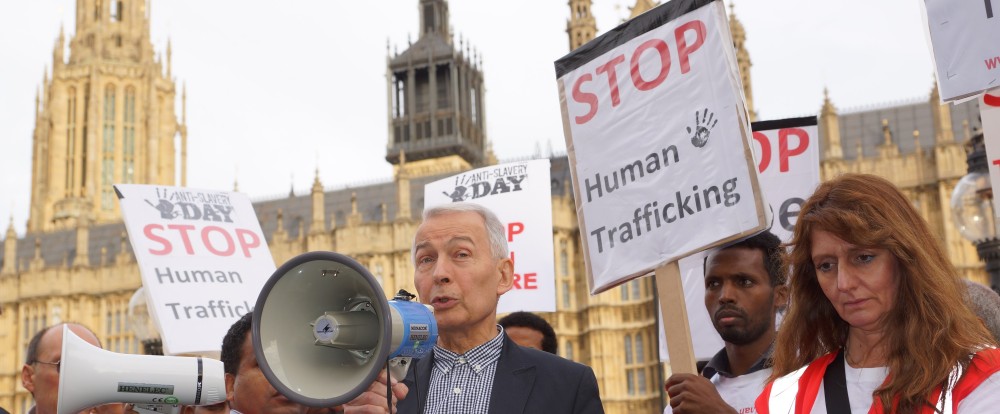The UN Palermo Protocol provides a definition of human trafficking which can be broken down into three essential elements:
The acquisition of a person;
By means of deception or coercion;
For the purpose of exploitation
Human trafficking, or modern slavery, is flexible and adapts as circumstances change. However, at its core all forms of trafficking have in common the control and exploitation of the vulnerable for the profit and gain of their traffickers.
People are exploited in all manner of ways, such as sexual exploitation, forced labour, domestic servitude, forced criminal activity, sham marriages and organ removal.
Facts and Figures
Estimates range from 21 million to 45 million people held in modern slavery around the world today.
Trafficking in human beings is a global business and the source of lucrative profits for traffickers and organised crime networks. It is the fastest growing international crime and the second largest source of illegal income worldwide. In 2014, the International Labour Office estimated the total profit obtained from the use of forced labour to be $150.2 billion per year.
Trafficking and Slavery in the UK
Owing to a variety of factors, including a widespread lack of awareness and the constantly evolving nature of the problem, it is difficult to gain an truly accurate picture of trafficking in the UK or elsewhere. Therefore, our understanding of the true extent and nature of human trafficking and modern slavery in the UK remains somewhat incomplete.
In 2015, 3,266 potential victims from 102 different countries of origin were referred into the National Referral Mechanism. In reality, however, the extent of human trafficking in the UK is likely to be far greater than the NRM statistics would suggest. The Home Office has estimated in its Modern Slavery Strategy that there may be as many as 13,000 people held in slavery in the UK. Exploitation in the UK takes a variety of forms, but most commonly forced labour, sexual exploitation, domestic servitude, and forced criminal activity.
A full breakdown of the NRM statistics can be found here.
The UK’s approach is now governed by the Modern Slavery Act. In Scotland and Northern Ireland, new legislation has also been introduced.
Trafficking or Smuggling?
Human trafficking and smuggling are often confused and sometimes incorrectly used interchangeably. Although there is often some overlap between instances of trafficking and smuggling, they are two legally distinct issues and should be recognised as such.
Smuggling involves facilitating an individual’s illegal passage over an international border. It is a criminal commercial transation between two willing parties, and once they reach the final destination the ‘customer’ is generally left to their own devices. As such there is no victim in the traditional sense, other than the State whose immigration rules have been broken.
Human trafficking, by contrast, involves force, threats and deception and specifically targets the trafficked person as an object of criminal exploitation for labour or services. There is, therefore, an identifiable victim who is subjected to exploitaiton. Human trafficking does not require an illegal border crossing, nor is it necessarily transnational, as there are many instances of internal trafficking.
Forced labour
Forced labour is the most common form of modern slavery and affects about 20 million people worldwide. It is also the least known method of enslavement. In ‘Disposable People’, Kevin Bales says that India “may have more slaves than all the other countries of the world put together” with the majority of slaves in India being Dalits or “untouchables.” Dalits comprise nearly one quarter of India’s society, with population estimates of 250 million people. Global research suggests that Dalits constitute the largest number of people categorised as victims of modern-day slavery.
Child Trafficking
Children are trafficked for all types of exploitation including sexual exploitation, forced labour, domestic servitude, forced marriage, illegal adoption and participation in criminal activities including pick-pocketing, shoplifting, ATM theft, cannabis cultivation, and benefit fraud. When trafficked children are abandoned they are usually without money, identification and anywhere to go. They are especially vulnerable to physical abuse, rape and being trafficked out of the UK.
Domestic servitude
Domestic workers are particularly vulnerable to exploitation and abuse. They work alone in an under-regulated sector and are reliant on their employer for their work, accommodation and immigration status. If the employer does not respect their rights, migrant domestic workers have little bargaining power and can find themselves in this invisible form of slavery. Cases of domestic servitude in the UK include both adults and children, normally migrants. Children in this situation are denied their right to go to school.
Trafficking for Sexual Exploitation
The scale of trafficking for sexual exploitation remains largely unknown since its very nature demands secrecy and reliable statistics are therefore not forthcoming. The trafficker receives all, or a percentage of, earnings. The sex industry depends on a large pool of women being moved around and exploited in different locations and venues often with debt and or coercion involved.

